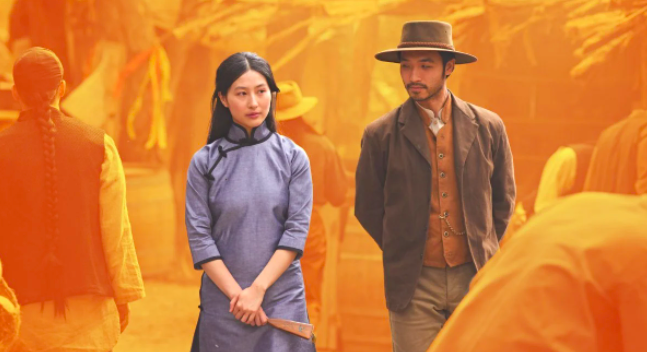
A scene from SBS’s New Gold Mountain.
Nothing like an election to see a bit of dirty linen being aired. The China syndrome among politicians keen to milk issues usually thrashed out behind diplomatic doors for their own domestic audience is an especially specious brand of soiled linen.
But all this holier-than-thou Manchurian manchester is nothing new when it comes to how we get along, or don’t get along, with China. And I mean nothing new at all.
We’ve been wheeling, dealing and wrangling with China for ages. And notwithstanding present anxieties about China’s expansionary ambitions, it’s rarely been with any great redeeming behaviour on our part.
I was intrigued to see a Chinese bloke on a Geelong-bound coach cutting out of Ballarat in the recent SBS mini-series New Gold Mountain. It suggested a degree of nearby civilisation when Victoria’s goldfields were about sleeping with a gun under your pillow as much as making your fortune.
Coaches might have offered some security, making the trip by foot could mean facing desperadoes, thieves and bushrangers. It really was the Wild West. Geelong might have been relatively safe, getting there wasn’t.
Many of the Chinese such as those in NGM were earlier escaping the murderous dangers of the Taiping Rebellion – started by the self-professed brother of Jesus Christ, maniac Hong Xiuquan.
In Australia, they faced antipathy from government and diggers, and violent attacks too. No surprise Germaine Greer says there’s no evidence the Chinese were among those fighting the good fight at Eureka. They weren’t exactly allowed in the tent.
For all the many Chinese contribution to Australia in years since, much was heavily glossed over, distilled to almost a culinary dim-sum bit part only. Thankfully, we’re sharper now. For this scribe, authors like Robert Macklin and Eric Rolls have been instructive.
China’s ties to Geelong might go way further back. A ‘Chinese oar’ found at Point Lonsdale in Geelong’s early days pre-dated William Buckley, according to local Aborigines. If you accept Chinese navigator Zheng He’s grand tour of Gavin Menzies’ book 1421 and many don’t – although Chinese President Hu Jintao has done so, addressing the Australian Parliament in 2003 – China discovered Australia three centuries before Cook.
Macassan fishermen were trading sea cucumber, harvested in northern Australia waters, with the Chinese maybe back as far as the 1200s. There are stories of kangaroos in the Chinese court in Confucius’ day, around 500BC.
The coach exiting Ballarat is really exiting the You Yangs. Their granite outcrops and slender eucalypts form much of the backdrop to NGM, with its cutting commentary on Chinese-Anglo relations of the era – and a Sovereign Hill ironically starved of its usual heavy complement of Chinese tourists by Covid.
One strong part of early Sino-Australia relations can be sheeted directly to Geelong and George Ernest Morrison. The son of Geelong College’s founder, a Times journalist, medico, adventurer and diplomat who had the 1904 Russo-Japanese War named after him, Morrison had a tribesman’s spearhead removed from his butt by Joseph Bell, the surgeon who inspired Conan Doyle’s Sherlock Holmes.
Morrison also exposed the blackbirding slave trade in Queensland’s cane fields and reportedly died twice, once in a race across New Guinea between The Age and The Argus, and again in the Fall of Peking.
But it was his Chinese ties – for two decades political adviser to Yuan Shih-Kai, president of the Republic of China government after the fall of dynastic China – that made him widely considered the biggest influence in Chinese politics.
‘Chinese’ Morrison also had a flair for non-political affairs: episodes in Marselles bordellos and affairs including with a German actress and a US heiress, detailed in Linda Javin’s book, A Most Immoral Woman. But that’s another story.
You’ll be hard pressed to find a more fascinating collection of contemporary Chinese photographs than Morrison’s in the NSW State Library. Everything from wildman hawkers and diplomats to arid, dry-gulch landscapes and gruelling executions. He’d have been right at home on the goldfields.
But each time I hear a politician banging on about China buddying up to the Solomons, I can’t help but think of Morrison exposing the black-birding and of today’s islanders still exploited on farms where Aussies won’t work because of appalling pay, conditions and other abuses.
Slave conditions is the standard criticism. Only last month, even the government was protesting about labour-hire companies leaving foreign workers as a little as $100 for a 73-hour week’s work.
From last week, workers are officially meant to be paid $25.41 an hour. It has been the going price for some time but plenty of workers have still been getting well and truly fleeced. Someone needs a good kick in the Kanakas.
So where do these islander workers come from? Well, Samoa is a common source as well as – you guessed it – the Solomons.
Funny thing, though. Back in the pre-Gold Rush days, China was a popular source of agricultural workers. I wonder if things might not go full circle, via the Pacific, once again,
This article appeared in the Geelong Advertiser 3 May 2022.


